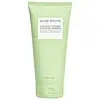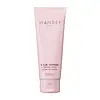What's inside
What's inside
 Key Ingredients
Key Ingredients

 Benefits
Benefits

 Concerns
Concerns

 Ingredients Side-by-side
Ingredients Side-by-side

Water
Skin ConditioningGlycerin
HumectantSodium Cocoyl Alaninate
Sodium Methyl Cocoyl Taurate
CleansingAcrylates/C10-30 Alkyl Acrylate Crosspolymer
Emulsion StabilisingInulin
Skin ConditioningButylene Glycol
HumectantCeramide NP
Skin ConditioningColloidal Oatmeal
AbsorbentCaprylyl Glycol
EmollientLauryl Hydroxysultaine
CleansingCoco-Glucoside
CleansingSodium Hyaluronate
HumectantPersea Gratissima Oil
Skin ConditioningPersea Gratissima Fruit Extract
EmollientSaccharide Isomerate
HumectantMicrococcus Lysate
Skin ConditioningGlyceryl Caprylate
EmollientPolyglyceryl-10 Laurate
Skin ConditioningStyrene/Acrylates Copolymer
Sodium Cocoyl Isethionate
Cleansing1,2-Hexanediol
Skin ConditioningEpidermidibacterium Keratini Ferment Filtrate
EmollientQuillaja Saponaria Bark Extract
CleansingSodium Phytate
Lecithin
EmollientDipotassium Glycyrrhizate
HumectantCitric Acid
BufferingMoringa Oleifera Seed Oil
EmollientSodium Citrate
BufferingButyl Avocadate
Skin ConditioningArginine
MaskingPhytosphingosine
Skin ConditioningHydrogenated Lecithin
EmulsifyingHydroxypropyltrimonium Hyaluronate
Mannose
HumectantHydrolyzed Hyaluronic Acid
HumectantSodium Acetylated Hyaluronate
HumectantMaltodextrin
AbsorbentTocopherol
AntioxidantHyaluronic Acid
HumectantHydrolyzed Sodium Hyaluronate
Skin ConditioningSodium Hyaluronate Crosspolymer
HumectantPotassium Hyaluronate
Skin ConditioningXanthan Gum
EmulsifyingAloe Ferox Leaf Extract
Skin ConditioningHexylene Glycol
EmulsifyingTriacetin
AntimicrobialGardenia Florida Fruit Extract
Skin ConditioningDextrin
AbsorbentParfum
MaskingWater, Glycerin, Sodium Cocoyl Alaninate, Sodium Methyl Cocoyl Taurate, Acrylates/C10-30 Alkyl Acrylate Crosspolymer, Inulin, Butylene Glycol, Ceramide NP, Colloidal Oatmeal, Caprylyl Glycol, Lauryl Hydroxysultaine, Coco-Glucoside, Sodium Hyaluronate, Persea Gratissima Oil, Persea Gratissima Fruit Extract, Saccharide Isomerate, Micrococcus Lysate, Glyceryl Caprylate, Polyglyceryl-10 Laurate, Styrene/Acrylates Copolymer, Sodium Cocoyl Isethionate, 1,2-Hexanediol, Epidermidibacterium Keratini Ferment Filtrate, Quillaja Saponaria Bark Extract, Sodium Phytate, Lecithin, Dipotassium Glycyrrhizate, Citric Acid, Moringa Oleifera Seed Oil, Sodium Citrate, Butyl Avocadate, Arginine, Phytosphingosine, Hydrogenated Lecithin, Hydroxypropyltrimonium Hyaluronate, Mannose, Hydrolyzed Hyaluronic Acid, Sodium Acetylated Hyaluronate, Maltodextrin, Tocopherol, Hyaluronic Acid, Hydrolyzed Sodium Hyaluronate, Sodium Hyaluronate Crosspolymer, Potassium Hyaluronate, Xanthan Gum, Aloe Ferox Leaf Extract, Hexylene Glycol, Triacetin, Gardenia Florida Fruit Extract, Dextrin, Parfum
Cetyl Ethylhexanoate
EmollientPolyglyceryl-3 Cocoate
EmulsifyingTrihydroxystearin
Skin ConditioningCetearyl Olivate
Sorbitan Olivate
EmulsifyingHydroxyacetophenone
AntioxidantDipropylene Glycol
HumectantCaprylyl Glycol
EmollientPyrus Communis Fruit Extract
Skin ConditioningOenothera Biennis Oil
EmollientEthylhexylglycerin
Skin ConditioningSimmondsia Chinensis Seed Oil
EmollientHedera Helix Leaf/Stem Extract
AntimicrobialHippophae Rhamnoides Oil
EmollientPyrus Malus Fruit Extract
Skin ConditioningFragaria Chiloensis Fruit Extract
Skin ConditioningDipotassium Glycyrrhizate
HumectantCetyl Ethylhexanoate, Polyglyceryl-3 Cocoate, Trihydroxystearin, Cetearyl Olivate, Sorbitan Olivate, Hydroxyacetophenone, Dipropylene Glycol, Caprylyl Glycol, Pyrus Communis Fruit Extract, Oenothera Biennis Oil, Ethylhexylglycerin, Simmondsia Chinensis Seed Oil, Hedera Helix Leaf/Stem Extract, Hippophae Rhamnoides Oil, Pyrus Malus Fruit Extract, Fragaria Chiloensis Fruit Extract, Dipotassium Glycyrrhizate
 Reviews
Reviews

Ingredients Explained
These ingredients are found in both products.
Ingredients higher up in an ingredient list are typically present in a larger amount.
Caprylyl Glycol is a humectant and emollient, meaning it attracts and preserves moisture.
It is a common ingredient in many products, especially those designed to hydrate skin. The primary benefits are retaining moisture, skin softening, and promoting a healthy skin barrier.
Though Caprylyl Glycol is an alcohol derived from fatty acids, it is not the kind that can dry out skin.
This ingredient is also used as a preservative to extend the life of products. It has slight antimicrobial properties.
Learn more about Caprylyl GlycolDipotassium Glycyrrhizate comes from licorice root.
Extracts of licorice have demonstrated to have antibacterial, anti‐inflammatory, antiviral, antioxidant properties.
One component, glabridin, has extra potent antioxidant and soothing properties. It has also been found to block pigmentation from UVB rays in guinea pigs.
Licorice Root also contains a flavonoid. Flavonoids are a natural substance from in plants. Flavonoids also have antioxidant properties.
Another component, glycyrrhizin, has been found to have anti-inflammatory and antimicrobial benefits. This may make licorice root extract effective at treating acne. However, more research is needed to support this.
Liquiritin is one of the flavone compounds found in licorice. It has been found to help lighten skin by preventing tyrosinase from reacting with tyrosine. When the two react, protein is converted to melanin. Melanin is the substance in your body that gives your features pigmentation.
Licorice root is native to Southern Europe and Asia. It has been used in traditional Chinese medicine to help with respiratory issues.
Learn more about Dipotassium Glycyrrhizate